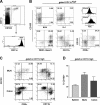Essential role for CD103 in the T cell-mediated regulation of experimental colitis
- PMID: 16216886
- PMCID: PMC2213206
- DOI: 10.1084/jem.20040662
Essential role for CD103 in the T cell-mediated regulation of experimental colitis
Abstract
The integrin CD103 is highly expressed at mucosal sites, but its role in mucosal immune regulation remains poorly understood. We have analyzed the functional role of CD103 in intestinal immune regulation using the T cell transfer model of colitis. Our results show no mandatory role for CD103 expression on T cells for either the development or CD4+CD25+ regulatory T (T reg) cell-mediated control of colitis. However, wild-type CD4+CD25+ T cells were unable to prevent colitis in immune-deficient recipients lacking CD103, demonstrating a nonredundant functional role for CD103 on host cells in T reg cell-mediated intestinal immune regulation. Non-T cell expression of CD103 is restricted primarily to CD11c(high)MHC class II(high) dendritic cells (DCs). This DC population is present at a high frequency in the gut-associated lymphoid tissue and appears to mediate a distinct functional role. Thus, CD103+ DCs, but not their CD103- counterparts, promoted expression of the gut-homing receptor CCR9 on T cells. Conversely, CD103- DCs promoted the differentiation of IFN-gamma-producing T cells. Collectively, these data suggest that CD103+ and CD103- DCs represent functionally distinct subsets and that CD103 expression on DCs influences the balance between effector and regulatory T cell activity in the intestine.
Figures






References
-
- Morrissey, P.J., K. Charrier, S. Braddy, D. Liggitt, and J.D. Watson. 1993. CD4+ T cells that express high levels of CD45RB induce wasting disease when transferred into congenic severe combined immunodeficient mice. Disease development is prevented by cotransfer of purified CD4+ T cells. J. Exp. Med. 178:237–244. - PMC - PubMed
-
- Powrie, F., M.W. Leach, S. Mauze, L.B. Caddle, and R.L. Coffman. 1993. Phenotypically distinct subsets of CD4+ T cells induce or protect from chronic intestinal inflammation in C. B-17 scid mice. Int. Immunol. 5:1461–1471. - PubMed
-
- Singh, B., S. Read, C. Asseman, V. Malmstrom, C. Mottet, L.A. Stephens, R. Stepankova, H. Tlaskalova, and F. Powrie. 2001. Control of intestinal inflammation by regulatory T cells. Immunol. Rev. 182:190–200. - PubMed
-
- Sakaguchi, S., N. Sakaguchi, J. Shimizu, S. Yamazaki, T. Sakihama, M. Itoh, Y. Kuniyasu, T. Nomura, M. Toda, and T. Takahashi. 2001. Immunologic tolerance maintained by CD25+ CD4+ regulatory T cells: their common role in controlling autoimmunity, tumor immunity, and transplantation tolerance. Immunol. Rev. 182:18–32. - PubMed
-
- Shevach, E.M. 2002. CD4+ CD25+ suppressor T cells: more questions than answers. Nat. Rev. Immunol. 2:389–400. - PubMed
Publication types
MeSH terms
Substances
Grants and funding
LinkOut - more resources
Full Text Sources
Other Literature Sources
Molecular Biology Databases
Research Materials

